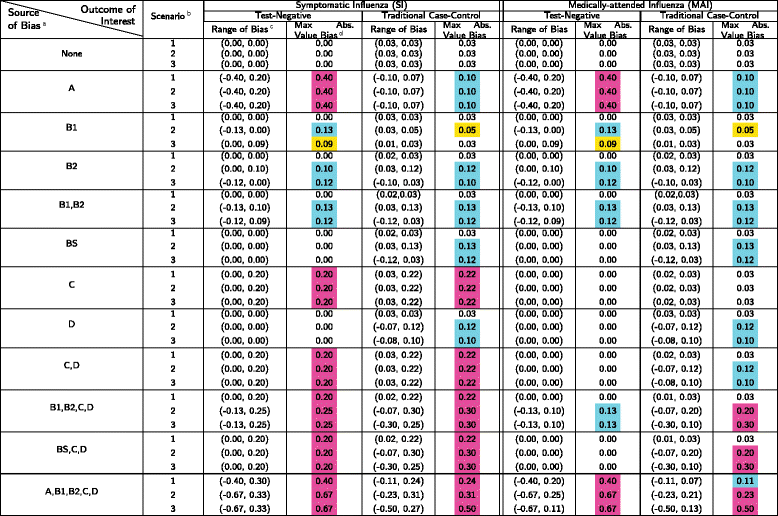Table 4.
Estimate of VE against symptomatic influenza and medically-attended influenza: range of bias and maximum absolute value of bias under various combinations of sources of bias

|
aSources of bias: A - vaccination affects the probability of non-influenza ARI (NFARI), B1 - health status affects the probability of NFARI, B2 - health status affects the probability of influenza ARI (FARI), BS is a special case of B1∩B2 where the probabilities of FARI and NFARI depend on health status but the effect of health status on these probabilities is the same for both types of ARI, C - vaccination affects the probability of seeking medical care for FARI while it does not affect the probabilities of seeking care for NFARI, D - health status affects the probabilities of seeking medical care against FARI and NFARI
bScenario: 1 - random vaccination, 2 - healthy person more likely than frail persons to be vaccinated, 3 - healthy person less likely than frail persons to be vaccinated
cBias = estimated VE - true VE. The range of the bias is the interval between the smallest and the largest value of the bias (accounting for the sign) using different combinations of the model parameters. The sign of bias indicates the direction of the difference between the estimated and the true VE. A negative sign corresponds to underestimation while a positive bias indicates overestimation
dMaximum absolute value of bias is largest difference between the estimated and the true VE when the sign of the difference in ignored: …Little or no bias (absolute bias less than 0.05),  Moderate bias (absolute bias greater than or equal to 0.05 and less than 0.10),
Moderate bias (absolute bias greater than or equal to 0.05 and less than 0.10),  Substantial bias (absolute bias greater than or equal to 0.10 and less than 0.20),
Substantial bias (absolute bias greater than or equal to 0.10 and less than 0.20),  Severe bias (absolute bias 0.20 or more)
Severe bias (absolute bias 0.20 or more)
Example: Under source of bias A, when the outcome of interest is SI, the TN study (under all vaccination scenarios) has a range of bias of (-0.40, 0.20). This means that the estimated VE varies from 0.20 (underestimating the true VE = 0.6 by 0.40) to 0.80 (overestimating the true VE by 0.20). When the sign of bias is ignored then the greatest difference between the estimated and the true VE is 0.40, hence the maximum absolute value of the bias is 0.40
